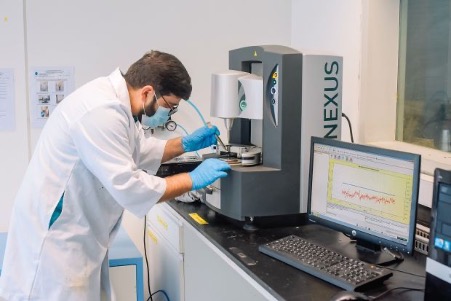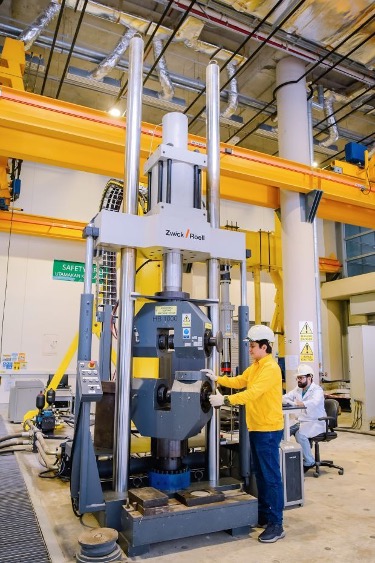Engineering a landmark future

The Dynamic Shear Rheometer is used to optimise bitumen performance and tyre track interaction for different applications including to cope with extreme conditions at airports and racetracks. It is an oscillatory testing device to assess the elastic and viscous nature of bituminous binders within a linear viscoelastic region across a range of temperature, frequency, stress and strain levels.
Universiti Teknologi PETRONAS (UTP)’s civil engineering programme bridges the gap between theory and real life, and incorporates industry-relevant information.
This move ensures that their graduates are job ready and enjoy higher employability, as well as suited to the requirements of employers from various sectors.
“From the Great Wall of China to the Sydney Opera House, Channel Tunnel and the Burj Khalifa, civil engineers have shaped human history through their landmark designs and achievements.
“Closer to home, the PETRONAS Twin Towers and infrastructure projects such as the SMART tunnel are the result of the talent, skill and expertise of civil engineers,” says Assoc Prof Dr Bashar S Mohammed.
“A civil engineer’s tasks include project planning, conceptualisation, design, construction, execution of maintenance and decommissioning at the end of structures’ service life. A variety of specialist sub-disciplines exists within the core civil engineering discipline.
“The specialisation requires enhanced skills and expertise. For example, the tasks of a construction engineer include managing and supervising project execution activities to ensure the project is completed on-time and meets the quality standards within the allocated budget.
“The structural engineer analyses and designs the project complying with the performance and functional requirements conforming to the prescribed criteria and ensures cost efficiency and safety throughout the service life. In addition, the structure should withstand all potential hazards such as earthquakes, windstorms, floods and fire.
“The duties of a transportation engineer include designing, executing, operating and maintaining transportation infrastructures. The types of transportation infrastructure are rapid mass transit systems, railway tracks, airports terminal, docks and harbours and bridges.
“Geotechnical engineers perform site investigation techniques, analyse and predict the performance and characteristics of soil, slope protection, soil stabilisation and reclamation.
“The extent of civil engineering also includes caring for the environment,” he explains.
Bashar elaborates that “environmental engineers provide solutions for resolving environmental issues. They usually deal with air pollution, wastewater treatment and solid waste disposal.
“Freshwater is an essential element of life, exploring water resources, designing, and maintaining hydraulic structures such as dams, channels, pipelines for storage and distribution of water.
“Energy resources such as fossil fuels are also available in the offshore basins, managed from the offshore structures. Offshore structures include fixed shallow water platforms, floating deepwater structures, and subsea facilities developments. These are designed and maintained by offshore engineers,” he says.
Bashar, who is UTP’s Chair of Civil and Environmental Engineering, says civil engineers are always in demand, and more so is the case for UTP graduates.
“More than 95% of our graduates secures employment within six months of graduation and they are employed by companies like Gamuda Bhd, IJM Construction Sdn Bhd, KLCC Projeks Sdn Bhd, Malakoff Corporation Bhd and Sime Darby Property Sdn Bhd,” he says, pointing out that this is the result of a carefully considered curriculum developed to ensure that undergraduates are job ready.
“All the programmes are reviewed constantly by the Industry Advisory Panel comprising professional engineers and other stakeholders to ensure that the curriculum meets industry requirement and considers current technological and environmental trends.”
At UTP, undergraduates of the civil engineering programme have a choice of majoring in offshore engineering, coastal engineering, geotechnical infrastructure engineering, environmental engineering, as well as building construction and repair.
“The course teaches students variable and transferable skills from problem solving to decision making and analysing, which can be applied to numerous engineering professions and consulting jobs,” he says.
UTP’s civil engineering programme is fully accredited by the Engineering Accreditation Council Malaysia and is recognised not only in Malaysia but by all the signatories of the Washington Accord such as the US, UK, Canada, Japan and Singapore. It also has the distinction of being in the Top 200 QS World University Rankings by Subject for Civil and Structural Engineering 2021.
A key attribute of UTP’s civil engineering programme is the quality and approach of the teaching and learning. Apart from the university’s diverse teaching faculty – comprising highly trained lecturers and professors, 30% of whom are professional engineers and chartered engineers – undergraduates also benefit from the expertise of adjunct lecturers.
“These are industry experts who share case studies and their workplace experiences with students, so that students are able to appreciate what is taught in the class and are able to better understand the application of theory on real life problems,” he adds.
The wave tank is used to simulate offshore study on structure, platform and vessel. The dimension of the tank measures approximately 22m in total length, 10m width, and 1.5m water depth. The wave is generated by a wave generator with 16 individual paddles. The other systems that are built into the wave tank include wave generator, current generator, remote control unit, signal generation computer and dynamic wave absorption beach.
He shares that some of the experts are from organisations such as PETRONAS Carigali, Akademi Sains Malaysia and UEM Group.
Students are also taken on visits to construction projects as well as sites for the building of highways, structures, and offshore platforms – exposing them to the realities and challenges of the work site.

The Universal Testing Machine is used to conduct tensile stress-strain tests for concrete and heavy structure materials.
“We have a good number of site visits per semester and even during the Covid-19 pandemic, site visits were conducted virtually,” he highlights.
Through the Centre for Excellence in Teaching and Learning (CETaL), innovative teaching and learning approaches through blended learning such as flipped classroom and hybrid classroom – which champions active learning – and the adoption of Fourth Industrial Revolution (IR 4.0) technologies such as augmented reality (AR) and virtual reality (VR) promote and enhance the learning experience. State-of-the-art labs and a wealth of publications and journals also set UTP apart from other universities.
The university’s seven-month industrial internship programme, unique among the country’s institutions of higher learning, is another advantage – ensuring that when they graduate, students are job ready.
With an alumni of more than 2,000 civil engineering graduates from more than 22 countries, the programme also boasts an active student involvement in competitions and clubs such as the UTP Civil Engineering Student Society and the Institution of Civil Engineers Student Chapter.
UTP, which is the top-ranking private university in Malaysia according to the Times Higher Education World University Rankings 2022, also has a high ratio of international community amongst the staff and students. This offers students a unique global intellectual and cultural experience.
For more information on UTP’s civil engineering programme, visit
here. 
